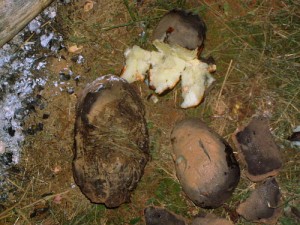
Successful cold storage
http://www.backwoodshome.com/articles2/gist82.html
By Sylvia Gist
-snip-
Ideally, I would have a root cellar which maintained the correct temperature for the produce I would like to keep. Unfortunately, it’s not that ideal, so I have to look for other places to store things. Fortunately, different vegetables like different temperatures, so everything doesn’t have to go in the same place. Other storage options (depending upon the item) include in the ground, under a staircase, unheated rooms, outside stairwells, pits in the ground, or extra refrigerators, to name a few.
A storage method is only the last step to having successful cold storage and fresh vegetables in the winter. The first step begins with the seed catalog; it is extremely important to choose cultivars which store well. For example, not every type of carrot will still be edible the following May. Most seed catalogs are good at telling us which ones have good storage qualities. I have relied on their recommendations and have found particular cultivars of a number of vegetables that store very well for me.
Planting time and harvest time also affect the success of storage. Many storage vegetables are planted later and harvested after frost. In the following discussion, I will note what works best for me as I deal with a fairly short growing season and cool nights.
-snip- --- FULL article can be found at link, above ---
Potatoes

Potatoes stored in a large basket on the floor of the fruit room
Potatoes are a traditional fresh storage food, but all cultivars are not equal. The challenge is to have an edible supply year around.
Last fall I stored Red Norland, Sangre Red, Yukon Gold, and Kennebec potatoes of all sizes. Red Norland sprouted first, followed by Kennebec, Yukon Gold, and Sangre Red. Sangre Red, also called Sangre, is a round-to-oblong, white fleshed red potato with shallow eyes. It is a very good new potato as well as being great for storage. Digging them is easy, as they generally cluster very near the plant; it is also a heavy producer. Even though a local nursery lists them as so-so keepers, Sangre has been the last to sprout in storage, with the largest potatoes keeping the best. I will eventually have to pull the sprouts from them also, but I do not have ideal storage facilities—just a room in the basement where I keep my canned goods, where the temperature ranges between 50° and 60° F during the year. Potatoes prefer 40 degrees. Colder temperatures will turn them sugary. Much too crisp and juicy for hash browns in the fall, these Sangres reach the perfect condition for frying in June and July.
By planting these early season potatoes the end of May, I get large potatoes by the end of August, which I harvest in late September. Planting earlier, I can have new potatoes earlier, but for storage it works better to plant later here where frosts may kill the tops the first of June and potatoes grow well into summer as the nights are cool and the days moderate.

 Trimitive or emergency cooking is accomplished usually with improvised culinary tools or perhaps with none at all. Many foods can be placed right on ash-covered coals to roast. Tubers and roots when placed on coals will turn black on the outside but the skin can be peeled off and the remaining portion tastes great, often with intensified flavors.
Trimitive or emergency cooking is accomplished usually with improvised culinary tools or perhaps with none at all. Many foods can be placed right on ash-covered coals to roast. Tubers and roots when placed on coals will turn black on the outside but the skin can be peeled off and the remaining portion tastes great, often with intensified flavors. Hat Tip to rick1, over at EHP-D:
Hat Tip to rick1, over at EHP-D: 

